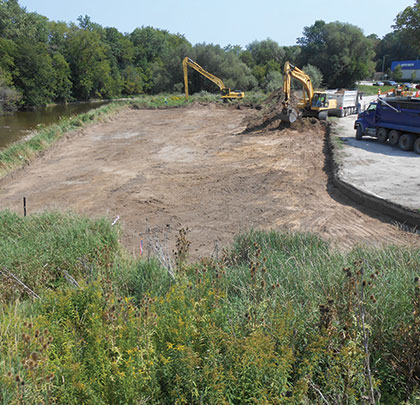The approximately 81-mile Sheboygan River meanders a bit in eastern Wisconsin before emptying into Lake Michigan at the city of Sheboygan, Wisconsin, located just 55 miles north of Milwaukee, 60 miles south of Green Bay.
Over the years, heavy manufacturing along the eastern section of the river had left Sheboygan’s downtown riverbed with a high concentration of PCBs and other chemicals, which made any form of swimming and other water sports in the river impossible. Adding to the cluster of problems was the overgrowth of invasive plants along the shore.
The area became a good candidate for federal assistance and became a Superfund site. Superfund is the common name for the Comprehensive Environmental Response, Compensation, and Liability Act of 1980, a federal law designed to clean up contaminated sites that pose present danger to people, animals, and the general environment. The Department of Natural Resources (DNR) has been using the Superfund in dredging the river to remove unwanted debris and sludge. More recently, the DNR has turned its attention to riverbank restoration and the removal of the toxic soil and invasive, aggressive weed grasses and reeds, which have quelled the recreational value of the river for the 115,000-plus residents of the immediate demographic area.
THE EXCAVATION CHALLENGE
The project requires complete excavation of the riverbank to thoroughly remove the contaminated soil and the thick, overgrown plants. Schneider Excavating, Inc. was hired by the general contractor, Lee & Ryan, a construction and environmental services company based in Greenfield, Indiana, to excavate the plants and provide a finished grade suitable for replanting.
“We need to dig deep enough in the silty soil to remove the entire root systems,” states Steve Ristow, president of Schneider Excavating. “We’re excavating anywhere from 18 inches to 3 feet deep, depending upon the plant being removed.”
The company used a Komatsu PC300-1 crawler excavator and a Volvo EC290C crawler excavator, both equipped with Topcon X-63 indicate excavator systems. Two Topcon HiPer Lite+ GPS base stations were strategically placed at the site. The HiPer Lite+ total station features 40-channel dual-frequency GPS plus GLONASS capability.
“The Topcon technology is very beneficial because we can delineate where deep-rooted phragmites grow versus other plants on our site plan,” says Michael Vanek, assistant project manager with Schneider Excavating. “With phragmites we need to excavate 3 feet to remove the root-massed plants. With the other grasses and weeds, we only need to excavate up to 2 feet.”
YARDS OF SOIL
The company built its site plan for the project and the Schneider Excavating engineer incorporated the topographical details showing the sections where the deep-rooted phragmites were growing. The site plan is viewable within the excavator’s operator compartment on the Topcon GX-60 excavator control display.
Schneider Excavating had four work areas on the site. They were responsible for 14,500 square feet of river shorefront at Esslingen Park, 32,000 square feet of river frontage at Kiwanis Park, 98,000 square feet on Wildwood Island (2.5 acre Island), and 72,000 square feet at the boat launch area found at intersection of Taylor Ave. and Indiana Ave.
A total of 15,000 cubic yards of rooty soil were excavated and trucked off site. Approximately 8,000 cubic yards of a sandy, topsoil mix were imported for the entire project.
“When we were running at our mass excavation peak, we were cycling through an average of 140 to 160 dump truck loads per day,” Vanek says. “It was interesting that during all the business we had fly fishermen working the river about 20 feet from our site, which is a pretty clear indicator that our work will be appreciated and used by the community.”
MACHINE CONTROL SOLUTION
One task where Vanek says that the 3D-MC machine control systems were truly needed was the placement of approximately 30 boulders in two locations in the river. The contractor used its extended-reach excavator for placing the boulders to create two barriers to create tranquil resting areas for the migrating trout and salmon. The fish can “catch their breath” behind the barriers before resuming their journeys.
For finish grading, Schneider Excavating used its John Deere 750K and John Deere 650K crawler bulldozers equipped with Topcon 3D-MC2 machine control systems for grading. The 3D-MC2 system uses Topcon’s GX-60 control box, MC-G3 GPS antenna, and MC-R3 GPS receiver, which is all controlled by software designed to provide position updates up to 100 times per second. The MC2 inertial sensor combines gyros and accelerometers to measure the X, Y, and Z positions as well as the roll, pitch, yaw, and acceleration of the dozer.
The grading tolerances were plus or minus 0.25 inches to provide a stable base for the landscape contractor to achieve the finished results that all are anticipating.
For the 2.5-acre Wildwood Island part of the project, Schneider Excavating built a temporary 600-foot bridge to reach it. They added 7,500 cubic yards to raise the island surface approximately 2 inches. They used the 650K bulldozer with the Topcon 3D-MC2 system to achieve a finish grade with a plus-minus 5-percent declining slope from its center peak down to the water. Additionally, a gravel bar was added around the island for anglers to stand while casting their lines.
“We achieved the finish grade easily and completed our 4-month portion of this 3-year project ahead of schedule by 8 days due in large part to our Topcon technology,” Ristow states. “Without the technology, we would have needed twice the crew and our costs would have risen 30 to 35 percent. And it would have taken longer to complete.” ■
About the Author:
Jeff Winke is a business and construction writer based in Milwaukee, Wisconsin. He can be reached through www.jeffwinke.com.
_________________________________________________________________________
Modern Contractor Solutions, October 2013
Did you enjoy this article?
Subscribe to the FREE Digital Edition of Modern Contractor Solutions magazine.

The Technology of River Shore Restoration


